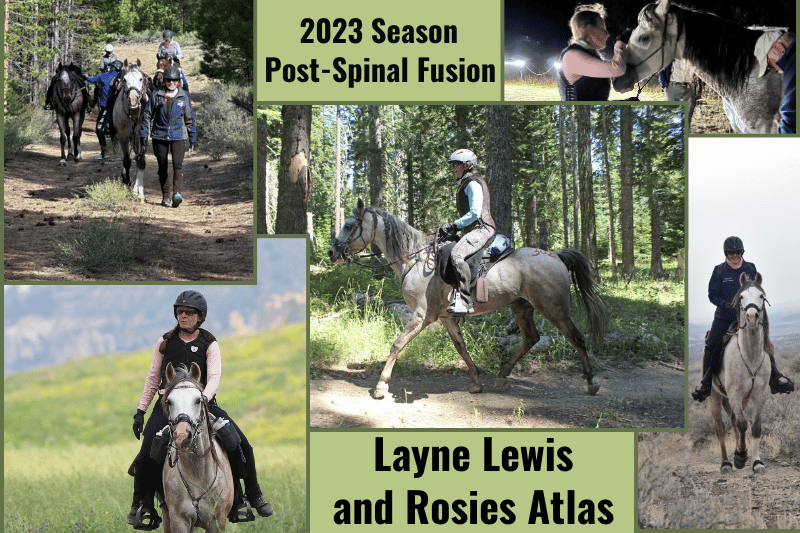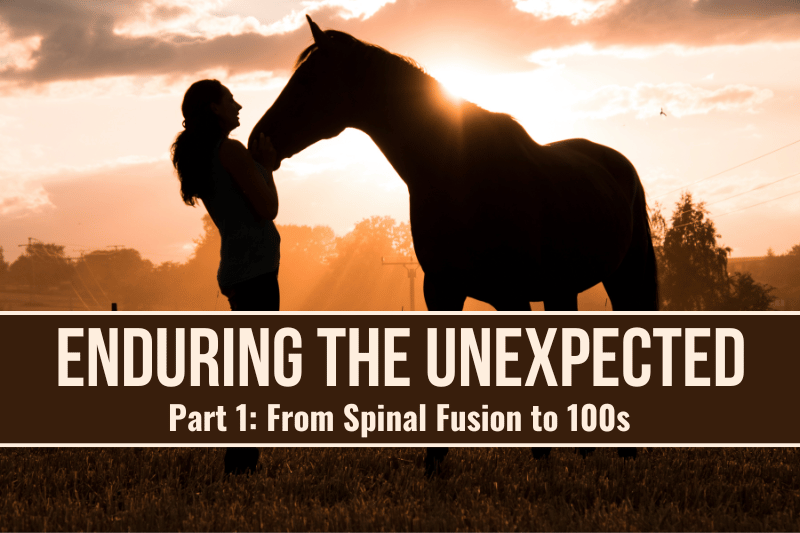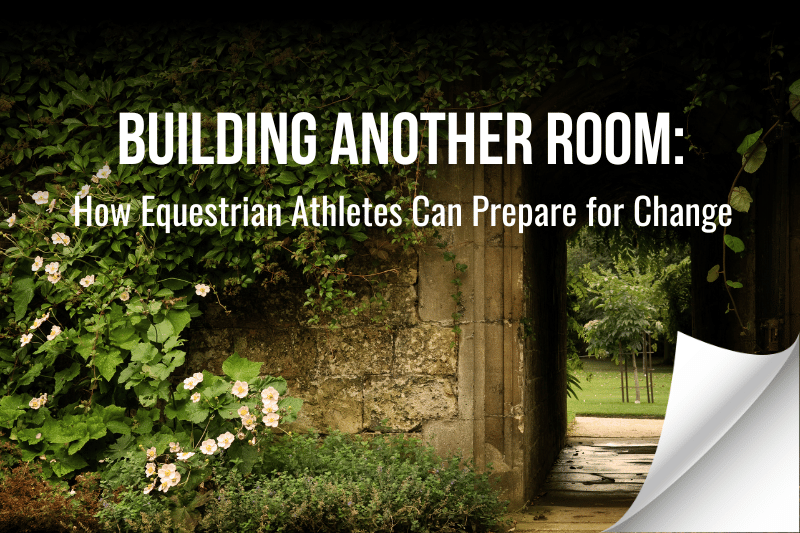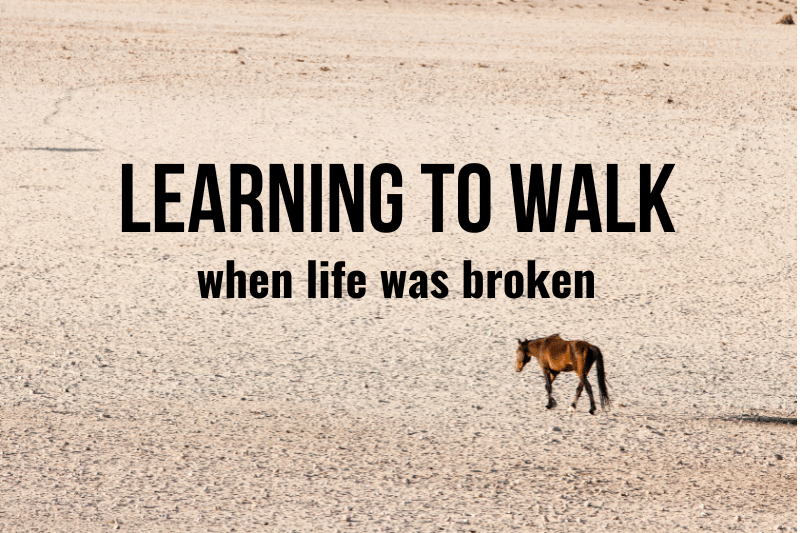I have a confession to make:
I am not the original sweaty equestrian. Sure, I claimed the domain name. I started the website. But I am only one rider on the coattails of others who chose to hone their own fitness alongside that of their horses, who carried the endurance mindset far beyond the trail. Theirs is the legacy that inspires me.
In my personal sphere, the OG sweaty equestrian is my great friend Layne Lewis. I doubt I’m the only one who would easily name her as the toughest person I know. In addition to being a multi-marathoner and full Ironman triathlete, she’s completed almost 9,000 AERC miles, including nineteen 100s.
Those accomplishments alone were impressive, but it’s what came next that solidifies her place in my personal Hall of Fame. Layne is not only gritty, but also curious, and wise, and relatably human. This is her story.
April 9, 2024: Interview with Endurance Rider Layne Lewis
The Sweaty Equestrian: Let's start with your wreck at the Old Selam Pioneer Ride in 2022. How do you remember that day?
Layne Lewis: I started the weekend with my good old standby Mickey. He was strong, fast, a little bit spunky. We were riding in front on day one and having a great time…right up until we weren’t.
I still don’t know exactly what happened. Mickey bolted up a hill, and then he bolted back down. At some point I came off him. I think I hit a tree. I got up right away, apparently unscathed except for a really painful hand.
I kept checking myself and thought, “I’m okay, I’m okay.”
I got back on.
By the time we reached vet check, there was swelling where I’d hit my left hip, but no real pain. I kind of sensed that something was wrong, but it didn’t hurt that badly, so I went back out.
Somewhere on that second loop, I felt so strange that I had to lay down. Right there on the trail, I got off and laid down on the ground until I improved enough to go on. The funny thing is, we still won the ride!
The next day, I was set to ride my new guy Atlas. Even though I still wasn’t in real pain, I downgraded from the 50 to the 25. Atlas top-tenned and I was feeling like I really had something in this guy – but I was also feeling like something wasn’t right.
In hindsight, I believe I somehow damaged the nerve bundle in my back when I hit, which caused there to be almost no pain at all…until there was massive pain. We went home Monday, and by Tuesday I was in excruciating pain.
I went to urgent care thinking I’d broken my pelvis. They took X-rays and came back to say, “You do not have a broken pelvis. However, there are some things in your spine we want to check.”
Okaaaaay….
They sent me to an orthopedic specialist. Hw looked at the images and said, “You need an MRI.”
By the time I actually got the MRI, my physical pain was getting better, but the doctors were making me nervous. What did I do to my back??
I was driving to a 100 when the specialist called. “I’m not going to touch this back,” he said. “You’re in bad shape. You need to go see a neurosurgeon.”
Uh-oh. “Does this mean I shouldn’t ride my horse?”
“Does it hurt?” he asked.
“No, not really.”
“Then keep moving.”
So I rode the 100 not knowing what the neurosurgeon was going to say.
What he said was “You need to have surgery right now.”
Diagnosis: Spondylolisthesis subsequent to osteoarthritis in an equestrian endurance rider, marathoner, and Ironman triathlete
Spondylolisthesis, affectionately known by its victims as “spondy,” is characterized by instability of the spine. The vertebrae move more than they should, potentially pressing on nerves. Patients may or may not experience symptoms such as pain or numbness in the lower back or legs.
In Layne’s severe case, spondylolisthesis resulted from osteoarthritis, a common degenerative joint disease in which broken-down cartilage leads to changes in the underlying bone.
Layne’s L3, L4, L5, and S1 were shifting around and impinging on her spinal cord.
TSE: So this condition was not caused by the accident at Old Selam. The fall just put you in enough pain that you got it checked out, right?
LL: Right. The fall exposed it. I was so shocked!
The neurosurgeon asked, “Aren’t you having any problems? Can you run?”
“Yep, I ran 4 miles yesterday.” I was training for a half-marathon!
“Do your legs feel heavy?”
I thought, yeah, but don’t they always feel heavy? Maybe I had been losing some function over all this time, and I just didn’t know it. I just figured I was a 50-something former athlete who had some battle scars. But once he started pointing out symptoms, I realized maybe I’d had something going on for a while.
This isn’t what I had planned for my mid-fifties. I was scared. I was very upset. We tried physical therapy because the last thing I wanted was surgery. Back surgery felt like a death sentence.
TSE: When you started Googling, like we all do in these situations, did you find any stories from equestrians who had been through a similar surgery for spondy?
LL: Googling was maybe not my best choice, because a lot of the people who post online are the ones who are still having trouble after failed spinal surgery.
I searched and searched, and I found one case study of a woman who was back to jumping four months after surgery. That’s the thing I held on to. At least somebody’s done it.
TSE: How did you spend the months leading up to your spinal fusion?
LL: Once I realized the situation I was in, I started training for surgery. I’d already done some really hard things in my life, so I chose to face surgery like it was just another athletic event.
I found out what physical therapy was going to look like and I started training for it. For example, I knew I wasn’t going to be able to bend, but I’d still have to pick things up, so I started doing very deep bodyweight squats.
I didn’t know whether I would come out in a wheelchair or unable to ride again, but I was determined to go in with my body as ready as it could be.
Meanwhile, Layne kept riding. She top-tenned a pair of 50s in spring 2022, then finished third at a 100 in May and won the Bandit Springs 100 in July. “It’s that mental component,” she told me. “The neurosurgeon said I wouldn’t do any more damage, so I figured, ‘Why not?’”
TSE: You went into surgery in August 2022. What were the first few days and weeks afterwards like?
LL: When I woke up, the surgeon said my back was in even worse shape than they’d thought, but everything went well. I now had 8 screws, 2 cages, and two rods in my spine. On the bright side, they were flexible rods.
Layne’s fitness level, strength, and bone health had made her eligible for flexible rods, which are relatively uncommon because patients often don’t meet all the criteria. As it turned out, this was only one of many ways in which her lifelong commitment to physical fitness prepared her to thrive after spondy.
The doctors got me walking right away, but I wasn’t supposed to do any incline. I live on a ranch. It’s all incline! So I walked to my kitchen and back, kitchen and back for five minutes. Then I sat down.
After a few days, I started walking outside. I walked 97 steps, which got me to see one horse. I gave him a little hug and walked back to lay on ice for another hour.
I didn’t take any narcotics because I know from experience that I don’t do well with them. I also didn’t want them to mask anything. As an athlete, I was taught to push through pain, but that was a bad idea now.
I had just one chance to get this right. I didn’t need to speed it up. I viewed it as a rest and recovery time.
TSE: When did you start thinking about trying to ride?
LL: They actually cleared me to ride months before I got on. It was hard. I was so scared, because I knew I had one chance to heal.
My physical therapist said I could ride about three months after the surgery, but I felt like unless I could saddle, put hoof boots on, and jump off – and feel comfortable doing all those things – I wasn’t going to get on.
TSE: What did you do to train for those self-imposed criteria?
LL: I put together a routine based on my history as an athlete and weightlifter. I started on a step and jumped off, and just slowly built myself up.
The first day I got on a horse, I sat there for five minutes and then I got off. That was my big day! But I knew my hips hadn’t been in the position for a long time and I needed to adjust.
I’ve known others who didn’t listen to the doctor, who just jumped right back on the horse. They either went back into surgery or will never be the same. I feel like I did not only what my doctor said, but also what I was comfortable with. I needed to feel safe.
I started going to a trainer – not just a physical therapist, but a personal trainer who could give me exercises I’d never thought about before and tell me if my form was wrong. For example, I now do step-ups where I stop at the top with my knee still in the air. That requires my whole hip girdle, my obliques, all those small muscles to work. It also requires balance, which we need for riding.
TSE: Did you do anything differently when you did start to ride, post-fusion?
LL: I just built it up slowly.
The surgeon said, “You cannot break anything I put in you.” That really was encouraging, but my back is now a single unit. I had to get used to new sensations when moving.
The first time I rode maybe half a mile, and I walked a lot. Then I trotted for ten nanoseconds to see how it felt. I was scared! I really was. But as long as I did the stretches and ice after, I was good. I found that riding actually made me feel better physically, not just mentally.
Also, I will not ride now without a protective vest.
TSE: Meanwhile, you finally had the promising horse you'd been breeding toward for years, but he was still young and you were still healing. How did Atlas play into your recovery experience?
LL: Prior to my diagnosis, I had ridden Atlas in his first 25 and 50, and he was pretty good. The spring before my surgery, while I was still trying to figure out what was going on with my back, a friend rode him in a 50 instead of me taking the risk. As it turned out, he remained strong but ratable.
Fast forward to 2023, the spring after my surgery. I rode Atlas in a 25. By then, I knew he was my steady-eddy and I wasn’t going to come off him. He’s just a good boy, even though he’s young.
We had trained quite a bit and I knew he was ready. I wasn’t sure that I was, but we were going to try it. Atlas and I were just a great team.
Atlas and Layne won that LD. She felt so good that they signed up for a 50 in May…then the Fort Howes 100 in June…then the Midnight Rider 100 in August. Throw in a few rides on a different horse, and Layne had a 355-mile season, all within a year of her spinal fusion surgery.

What a happy ending, right?
Not so fast.
In fall 2023, I was in the Burlington airport when my phone rang. It was Layne.
“I need another fusion,” she said, and my heart sank. Not again!
Check out Part 2 of my interview with Layne Lewis. She shares the recovery strategies that got her back in the saddle yet again, plus her ambitious plans for 2024…and another plot twist. If you know a rider who is facing spondylolisthesis, osteoarthritis, spinal fusion, or any serious medical challenge, please share Layne’s story. Help us spread the hope!
Remember to join my newsletter to get a heads up on new posts, right to your inbox.




I am 80, riding regularly, with spondy, osteoarthritis, told I need surgery, and managing with steroid injections. Yes, I ride, not as far or as long, and stay relatively fit. The key is not stopping, not giving up.
I love this!